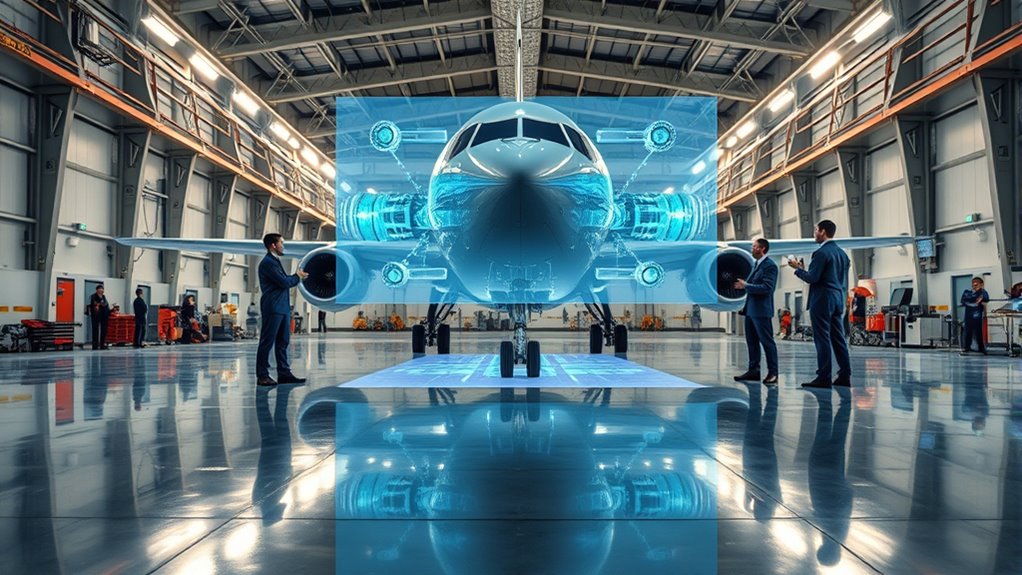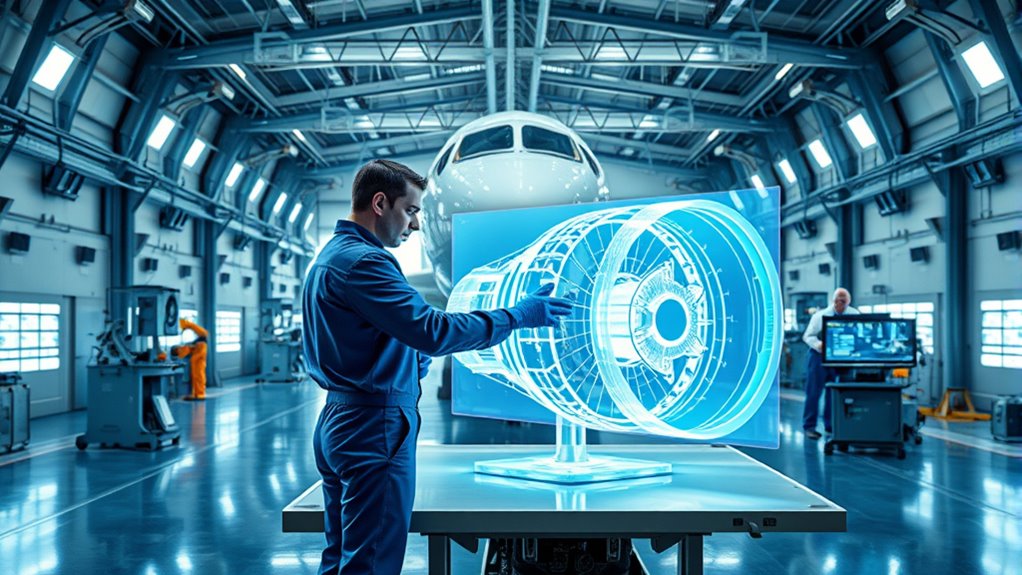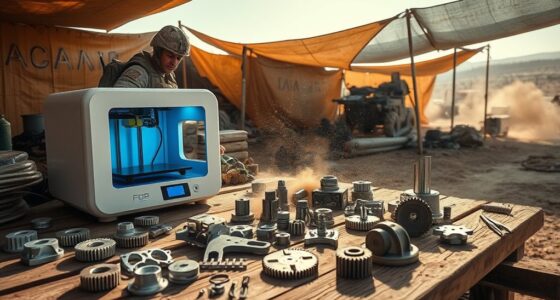Digital twins transform aircraft maintenance and training by creating virtual models of aircraft systems that let you monitor, analyze, and simulate real-time data safely and cost-effectively. They enable immersive, realistic training scenarios using virtual reality, helping you practice troubleshooting and repairs without risking damage. Additionally, they support remote diagnostics and proactive maintenance planning, reducing downtime. Keep exploring how these advanced digital tools can make aviation safer, more efficient, and smarter.
Key Takeaways
- Digital twins create virtual replicas of aircraft systems for real-time monitoring and analysis.
- They enable immersive training environments with realistic simulations based on actual aircraft data.
- Digital twins facilitate predictive maintenance by forecasting potential failures and optimizing repairs.
- They support remote diagnostics and maintenance planning, reducing aircraft downtime and response times.
- Integrating digital twins enhances safety, reduces costs, and transforms aircraft maintenance and training into a data-driven process.

Have you ever wondered how digital technology is transforming aircraft maintenance and training? One of the most exciting advancements is the use of digital twins, which create virtual replicas of aircraft systems. These digital twins enable you to monitor, analyze, and simulate real-time data, providing a thorough understanding of an aircraft’s performance without physically interacting with the actual machine. By integrating virtual reality into this process, you can step into an immersive environment where you examine aircraft components closely, troubleshoot issues, and practice repairs in a safe, controlled setting. Virtual reality makes training more engaging and effective, allowing you to develop skills faster and with less risk. It’s like having a hands-on experience without the wear and tear on actual aircraft parts.
Digital twins and virtual reality revolutionize aircraft maintenance and training with immersive, safe, and efficient simulation and analysis.
Predictive analytics plays a vital role here as well. With vast amounts of data collected from sensors embedded in aircraft, predictive analytics helps you forecast potential failures or maintenance needs before they happen. Instead of waiting for a part to break down, you can proactively address issues, reducing downtime and saving costs. This technology continuously analyzes patterns and trends, alerting you when maintenance is likely needed, which means you can plan interventions more efficiently. By combining predictive analytics with digital twins, you gain a real-time, data-driven view of aircraft health, enabling you to make smarter, faster decisions. Additionally, the integration of AI security ensures that sensitive operational data remains protected from cyber threats, safeguarding both safety and privacy.
This digital approach also enhances training programs by providing realistic simulations based on actual aircraft data. When you’re using virtual reality to train, you’re working with scenarios that mirror real-world conditions, making your learning experience more practical and applicable. The digital twin acts as a dynamic practice ground, where you can experiment with different repair techniques or troubleshoot issues without risking safety or incurring costs. As you gain confidence and expertise, these simulations can be adjusted to increase complexity, mirroring real operational challenges.
Furthermore, digital twins allow you to perform remote diagnostics and maintenance planning. Instead of dispatching technicians physically to the aircraft, you can analyze data remotely, diagnose issues, and guide repairs through augmented reality or virtual interfaces. This not only accelerates response times but also expands access to expert knowledge, regardless of location.
In essence, digital twins, augmented by virtual reality and predictive analytics, are revolutionizing how you maintain and train for aircraft operations. They provide smarter, safer, and more efficient workflows, ensuring aircraft are kept in prime condition while reducing costs and downtime. This technological shift is transforming the aviation industry into a more innovative, data-driven domain where precision and proactive management are the standards.
Frequently Asked Questions
How Do Digital Twins Improve Aircraft Safety Beyond Maintenance?
Digital twins enhance aircraft safety by providing real-time monitoring and predictive insights, helping you identify potential issues before they escalate. They allow you to simulate responses to emergencies, improving your preparedness. However, you must manage cybersecurity risks and protect data privacy, as sensitive information could be vulnerable. By addressing these concerns, digital twins can markedly boost safety, ensuring your aircraft operate reliably and securely throughout their lifespan.
What Are the Costs Associated With Implementing Digital Twin Technology?
You might think digital twin technology costs a fortune, but a thorough cost analysis shows initial investments cover hardware, software, and training. While setup can be pricey upfront, the long-term savings from improved maintenance and safety often outweigh these costs. You’ll also need ongoing updates and support, but the enhanced efficiency and risk reduction make it a smart, cost-effective choice for your aircraft operations in the long run.
How Do Digital Twins Integrate With Existing Aircraft Systems?
You integrate digital twins with existing aircraft systems through sensor integration and real-time data synchronization. Sensors installed on aircraft collect data continuously, which the digital twin accesses and updates instantaneously. This seamless connection allows you to monitor system performance, diagnose issues, and predict maintenance needs efficiently. By ensuring real-time data flow, digital twins become an essential tool in enhancing operational accuracy and reducing downtime, fitting smoothly into your current aircraft management processes.
What Are the Challenges in Creating Accurate Digital Twin Models?
Imagine building a detailed map of a vast, unpredictable forest; that’s what creating an accurate digital twin model feels like. You face challenges like ensuring data accuracy, so every detail reflects reality, and managing model complexity, as intricate systems demand sophisticated representations. If you overlook data quality or oversimplify, your model loses reliability, making it harder to predict issues. Precision and thoroughness are your guiding stars in this intricate construction.
How Do Digital Twins Support Pilot Training Programs?
Digital twins support pilot training programs by offering realistic virtual simulations that replicate real aircraft systems and scenarios. You can practice emergency procedures, routine checks, and decision-making in a safe environment. These virtual simulations enable you to assess your skills effectively through real-time feedback and skill assessment tools. This hands-on approach helps you build confidence and competence before flying actual aircraft, enhancing overall safety and performance.
Conclusion
Embracing digital twins in aircraft maintenance and training transforms your approach, making complex tasks feel like second nature. You get real-time insights, reduce errors, and streamline operations. Think of it as having a crystal ball—anticipating issues before they happen. Remember, “A stitch in time saves nine.” By investing in this technology now, you’re safeguarding your future, ensuring smooth flights and confident crews. The sky’s the limit when you harness the power of digital twins.









